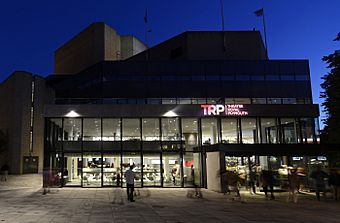Theatre Royal, Plymouth facts for kids

Main entrance of Theatre Royal Plymouth
|
|
| Address | Royal Parade Plymouth UK |
|---|---|
| Type | Producing and Receiving House |
| Capacity | 1,320 |
| Construction | |
| Opened | 1982 |
| Architect | Peter Moro |
| Website | |
| http://www.theatreroyal.com | |
| Address | Cattedown Plymouth UK |
|---|---|
| Type | Production and Learning Centre |
| Construction | |
| Opened | 2002 |
| Architect | Ian Ritchie |
The Theatre Royal, Plymouth, is a popular theatre in Plymouth, Devon, UK. It has three main performance areas. The largest is The Lyric, which seats about 1,300 people. It often shows big musicals, opera, and ballet. There's also The Drum, a smaller studio with 200 seats, and The Lab, an even smaller studio for about 50 people.
The theatre also has a special building called TR2. This is a production and learning centre. Here, they have rehearsal rooms and workshops where they make sets and costumes for shows. The Theatre Royal Plymouth gets regular funding from Arts Council England to help it run.
In 2013, the theatre completed a big £7 million project. This updated the front entrance and added The Lab, a new space for community performances. In 2019, a large bronze sculpture called Messenger was placed outside the theatre. It shows a crouching female actor and is 7 metres (23 feet) tall.
Contents
History of Plymouth Theatres
The first theatre in Plymouth was built in 1758 on George Street. It was first called the Theatre, Frankfort-Gate. Later, it became the Theatre Royal after King George III and his family visited in 1789.
Designing a New Theatre
In 1810, Plymouth Corporation held a contest to design a new theatre, hotel, and meeting rooms. John Foulston won this contest. He built a grand block of buildings between 1811 and 1813. The new Theatre Royal opened in 1813 and could seat 1,192 people.
Foulston's buildings had a large front facing George's Place. It featured a big entrance with tall columns. The theatre was on one side, and the hotel and meeting rooms were on the other. Foulston used very thick walls to protect the theatre from fire. He also used cast iron inside, believing it made the theatre fireproof. Even with these steps, a fire badly damaged the theatre's inside in June 1878. But it was quickly repaired and reopened by January 1879.
From Theatre to Cinema and Back
Over time, fewer people went to the theatre because cinemas became popular. So, the old theatre building was torn down in 1937. A large cinema called the Royal Cinema was built in its place, opening in 1938. This cinema survived the Plymouth Blitz during the Second World War, even though the nearby hotel was destroyed.
By 1954, fewer people went to the cinema because television became popular. So, the cinema was partly changed back into a theatre and called the Theatre Royal Cinema. It changed names a few more times, becoming the ABC Plymouth in 1958. It was later divided into three screens in 1977. The cinema finally closed its doors in February 2019.
The Current Theatre Royal
The current Theatre Royal was designed in 1977 by the Peter Moro Partnership. They had designed other new theatres across the country. Building started in 1979, and Princess Margaret officially opened the theatre on May 5, 1982. The theatre has a unique design style called "brutalist" architecture. Many people praise its design.
The Lyric: Main Stage Shows
The Lyric is the main auditorium and can seat 1,315 people. It has a special design that allows it to become smaller, creating a more cozy space for 787 people. It has a steep seating area with two upper levels and a very large stage opening.
The Lyric hosts many different types of shows. These include big touring plays and musicals. It also welcomes famous opera and dance groups. For example, the Birmingham Royal Ballet and the Welsh National Opera have performed here. In 2019, The SpongeBob Musical was even filmed here for television with a live audience. The Lyric also creates its own plays and musicals each year, often working with other companies.
The Drum: New Plays and Ideas
The Drum is a smaller theatre space that seats 200 people. It focuses on creating and showing new plays. It is well-known for its fresh and exciting shows. In 2007, The Drum won the Peter Brook Empty Space Award. It often works with other theatre groups and venues, like the Royal Court and the Bush Theatre, to bring new stories to life.
TR2: Production and Learning Centre
The Production and Learning Centre, known as TR2, is located by the River Plym. It was designed by Ian Ritchie Architects. This building has workshops where they build sets, make costumes, and create props for all the theatre's shows. It also has rehearsal rooms for actors and dancers. TR2 runs one of the biggest education and outreach programs for a regional theatre in the UK. This means they offer many activities and learning opportunities for people in the community.


